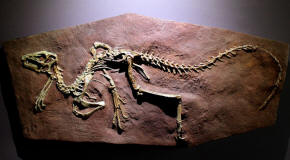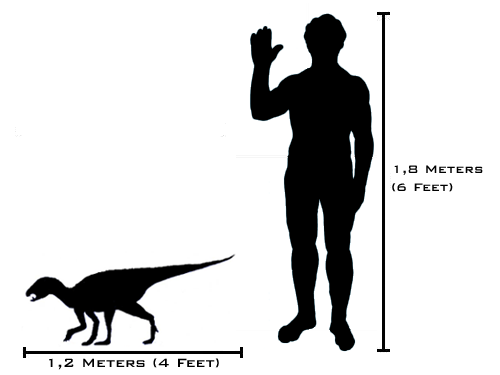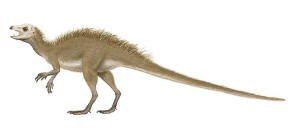|
Description
Among heterodontosaurids, only
Heterodontosaurus itself is known from a complete skeleton.
Fragmentary skeletal remains of
Abrictosaurus are known but have not been fully described, while
most other heterodontosaurids are known only from jaw fragments and teeth.
Consequently, most heterodontosaurid
synapomorphies (defining features) have been described from the teeth
and jaw bones. Heterodontosaurus measured just over 1 meter (3.3 ft)
in length, while the fragmentary remains of
Lycorhinus indicate an animal up to twice that size.
Skull and teeth
Both Abrictosaurus and
Heterodontosaurus had very large
eyes. Heterodontosaurids are named for their strongly
heterodont
dentition.
There were three premaxillary teeth. In the
Early Jurassic Abrictosaurus,
Heterodontosaurus, and
Lycorhinus, the first two premaxillary teeth were small and conical,
while the much larger third tooth resembled the canines of
carnivoran mammals and is often called the caniniform or 'tusk'. A lower
caniniform, larger than the upper, took the first position in the dentary
and was accommodated by the arched diastema of the upper jaw when the mouth
was closed. These caniniforms were serrated on both the anterior and
posterior edges in Heterodontosaurus and
Lycorhinus, while
those of Abrictosaurus bore serrations only on the anterior edge. In
the
Early Cretaceous Echinodon, there may have been two upper
caniniforms, which were on the maxilla rather than the premaxilla, and
Fruitadens from the
Late Jurassic may have had two lower caniniforms on each dentary.
Skeleton
The postcranial anatomy of
Heterodontosaurus tucki has been
well-described, although H. tucki is generally considered the most
derived of the Early Jurassic heterodontosaurids, so it is impossible to
know how many of its features were shared with other species. The forelimbs
were long for a dinosaur, over 70% of the length of the hindlimbs. The
well-developed deltopectoral crest (a ridge for the attachment of
chest and
shoulder muscles) of the
humerus
and prominent
olecranon
process (where
muscles that extend the forearm were attached) of the
ulna indicate
that the forelimb was powerful as well. There were five digits on the
manus ('hand'). The first was large, tipped with a sharply curved claw,
and would rotate inwards when flexed;
Robert Bakker called it the 'twist-thumb'. The second digit was the
longest, slightly longer than the third. Both of these digits bore claws,
while the clawless fourth and fifth digits were very small and simple in
comparison. In the hindlimb, the
tibia was 30%
longer than the
femur, which is generally considered an adaptation for speed. The tibia
and
fibula
of the lower leg were fused to the
astragalus and
calcaneum
of the ankle, forming a 'tibiofibiotarsus'
convergently with modern
birds. Also
similarly to birds, the lower
tarsal (ankle) bones and
metatarsals were fused to form a 'tarsometatarsus.'
There are four digits in the
pes (hindfoot), with only the second, third, and fourth contacting the
ground. The tail, unlike many other ornithischians, did not have
ossified
tendons to maintain a rigid posture and was probably flexible. The
fragmentary skeleton known for Abrictosaurus has never been fully
described, although the forelimb and manus were smaller than in
Heterodontosaurus. Also, the fourth and fifth digits of the forelimb
each bear one fewer
phalanx bone.
Proto-feathers
Tianyulong from China appears to preserve filamentous integument
which has been interpreted to be a variant of the proto-feathers found in
some theropods. These filaments include a crest along its tail. The presence
of this filamentous integument has been used to suggest that both
ornithischians and saurischians were endothermic.
Classification
Heterodontosauridae includes the genera
Abrictosaurus,
Lycorhinus, and
Heterodontosaurus, all from South Africa. While
Richard Thulborn once reassigned all three to
Lycorhinus, all
other authors consider the three genera distinct. Within the family,
Heterodontosaurus and
Lycorhinus are considered
sister taxa, with
Abrictosaurus as a basal member.
Geranosaurus is also a heterodontosaurid, but is usually considered a
nomen dubium because the type specimen is missing all its teeth,
making it indistinguishable from any other genus in the family. More
recently, the genus Echinodon has been considered a heterodontosaurid
in several studies.
Lanasaurus was named for an upper jaw in 1975, but more recent
discoveries have shown that it belongs to Lycorhinus instead, making
Lanasaurus a
junior synonym of that genus.
Distribution
While originally known only from the Early Jurassic of southern Africa,
heterodontosaurid remains are now known from four
continents. Early in heterodontosaurid history, the
supercontinent
Pangaea
was still largely intact, allowing the family to achieve a near-worldwide
distribution. The oldest known remains are a jaw fragment and isolated
teeth from the
Laguna Colorada Formation of
Argentina,
which dates back to the
Late Triassic. These remains have a derived morphology similar to
Heterodontosaurus, including a caniniform with serrations on both
anterior and posterior edges, as well as high-crowned maxillary teeth
lacking a cingulum. The most diverse heterodontosaurid
fauna comes
from the Early Jurassic of southern Africa, where fossils of
Heterodontosaurus,
Abrictosaurus,
Lycorhinus, and the
dubious Geranosaurus are found.
Undescribed Early Jurassic heterodontosaurids are also known from the
United States and
Mexico,
respectively. In addition, beginning in the 1970s, a great deal of fossil
material was discovered from the Late Jurassic
Morrison Formation near
Fruita, Colorado in the United States. Described in print in 2009, this material
was placed in the genus
Fruitadens. Heterodontosaurid teeth lacking a cingulum have also
been described from Late Jurassic and Early Cretaceous formations in
Spain and
Portugal.
The remains of
Echinodon were redescribed in 2002, showing that it
may represent a late-surviving heterodontosaurid from the
Berriasian stage of the Early Cretaceous in southern England.
One late surviving Asian form is
known (Tianyulong).
Paleobiology
Most heterodontosaurid fossils are found in
geologic formations that represent arid to semi-arid environments,
including the
Upper Elliot Formation of
South Africa and the
Purbeck Beds of southern England. It has been suggested that
heterodontosaurids underwent seasonal
aestivation or
hibernation during the driest times of year. Due to the lack of
replacement teeth in most heterodontosaurids, it was proposed that the
entire set of teeth was replaced during this dormant period, as it seemed
that continual and sporadic replacement of teeth would interrupt the
function of the tooth row as a single chewing surface. However, this was
based on a misunderstanding of heterodontosaurid jaw mechanics. It was
thought that heterodontosaurids actually did replace their teeth
continually, though more slowly than in other
reptiles,
but
CT scanning of skulls from juvenile and mature
Heterodontosaurus
shows no replacement teeth. There is currently no evidence that supports the
hypothesis of aestivation in heterodontosaurids, but it cannot be
rejected, based on the skull scans.
While the cheek teeth of heterodontosaurids are clearly adapted for
grinding tough plant material, their diet may have been omnivorous. The
pointed premaxillary teeth and sharp, curved claws on the forelimbs suggest
some degree of predatory behavior. It has been suggested that the long,
powerful forelimbs of Heterodontosaurus may have been useful for
tearing into insect nests, similarly to modern
anteaters.
These forelimbs may have also functioned as digging tools, perhaps for
roots and
tubers.
The length of the forelimb compared to the hindlimb suggests that
Heterodontosaurus might have been partially
quadrupedal, and the prominent olecranon process and hyperextendable
digits of the forelimb are found in many quadrupeds. However, the manus is
clearly designed for grasping, not weight support. Many features of the
hindlimb, including the long tibia and foot, as well as the fusion of the
tibiofibiotarsus and tarsometatarsus, indicate that heterodontosaurids were
adapted to run quickly on the hindlegs, so it is unlikely that
Heterodontosaurus moved on all four limbs except perhaps when feeding.
The short tusks found in all known heterodontosaurids strongly resemble
tusks found in modern
musk deer,
peccaries
and pigs.
In many of these animals (as well as the longer-tusked
walrus and
Asian elephants), this is a
sexually dimorphic trait, with tusks only found in males. The
type specimen of
Abrictosaurus lacks tusks and was originally
described as a female. While this remains possible, the unfused
sacral
vertebrae and short face indicate that this specimen represents a
juvenile animal, while a second, larger specimen of
Abrictosaurus
clearly possesses tusks. Therefore, it is possible that tusks are found only
in adults, rather than being a
secondary sexual characteristic of males. These tusks could have been
used for combat or
display with members of the same species or with other species. The
absence of tusks in juvenile
Abrictosaurus could also be another
characteristic separating it from other heterodontosaurids as well, as tusks
are known in juvenile Heterodontosaurus. Other proposed functions for
the tusks include defense and use in an occasionally omnivorous diet.
Return to the
Old Earth Ministries Online Dinosaur
Curriculum homepage.

Shopping
Bay
State Replicas - None
Black
Hills Institute - None
|


